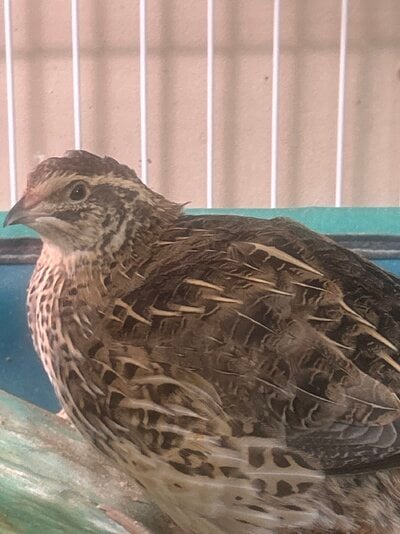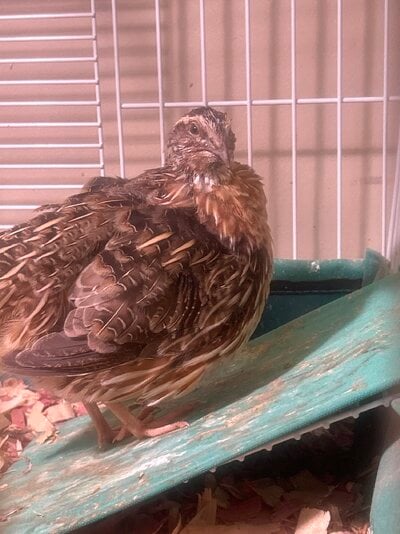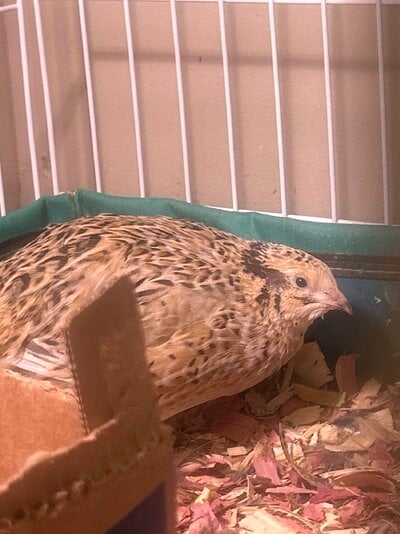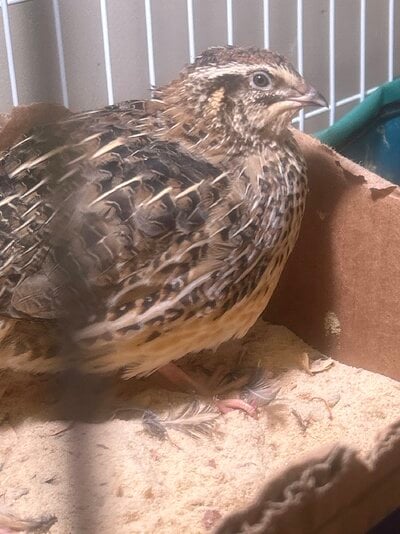Hello,
I am new to quail farming and forum posting altogether, so please bear with me if I’ve missed something.
I am hoping to gain some insight on the types of quail I’m raising and if it’s the reason for their differences in temperament.
Right now I have one male and three females in a 2ftx3ft cage indoors. I am planning to move them into a large aviary outside once the weather warms consistently, as they are still very young. All of the eggs I’ve received were labeled as Coturnix.
My first hatch was from a batch of ten eggs I got from Amazon, I only managed to hatch a single egg, which I chalk up to my ignorance. This quail is by far my favorite of the flock and she is currently around 5 months old. She has the lighter color and smaller build and her temperament is very noticeably more relaxed than the others. The male even seems totally disinterested in mounting her and the females rarely interact with her at all. She stays on the opposite side of the cage.
The other two females and the male I hatched from a second batch of ten eggs I got from a local farm. Both of these batches were labeled as Coturnix quail, but these quail seem larger, much darker in color, and are absolutely bonkers in comparison. They are currently 2-3 months old. The male is always mounting one of the two females, which I expected, but they jump and run around the cage almost stomping on the older quail. The two females even seem to chase and peck at each other often, but never the older quail.
So from here, I have several questions.
1) Did I end up with completely different breeds of quail?
2) Will this affect any offspring they have, their colors and temperaments, etc? Can they be bred together?
3) Is their difference in temperament due to breed or simply differences in personality?
4) Is the size of their current enclosure the cause of their behavior and should I hasten their transition to the outdoor enclosure?
5) Should I separate the more relaxed quail from the others?
6) Is there any other advice you can offer me?
Thank you for reading, answering any questions, and understanding my ignorance. Their ruffled appearance I believe is due to them molting.
I am new to quail farming and forum posting altogether, so please bear with me if I’ve missed something.
I am hoping to gain some insight on the types of quail I’m raising and if it’s the reason for their differences in temperament.
Right now I have one male and three females in a 2ftx3ft cage indoors. I am planning to move them into a large aviary outside once the weather warms consistently, as they are still very young. All of the eggs I’ve received were labeled as Coturnix.
My first hatch was from a batch of ten eggs I got from Amazon, I only managed to hatch a single egg, which I chalk up to my ignorance. This quail is by far my favorite of the flock and she is currently around 5 months old. She has the lighter color and smaller build and her temperament is very noticeably more relaxed than the others. The male even seems totally disinterested in mounting her and the females rarely interact with her at all. She stays on the opposite side of the cage.
The other two females and the male I hatched from a second batch of ten eggs I got from a local farm. Both of these batches were labeled as Coturnix quail, but these quail seem larger, much darker in color, and are absolutely bonkers in comparison. They are currently 2-3 months old. The male is always mounting one of the two females, which I expected, but they jump and run around the cage almost stomping on the older quail. The two females even seem to chase and peck at each other often, but never the older quail.
So from here, I have several questions.
1) Did I end up with completely different breeds of quail?
2) Will this affect any offspring they have, their colors and temperaments, etc? Can they be bred together?
3) Is their difference in temperament due to breed or simply differences in personality?
4) Is the size of their current enclosure the cause of their behavior and should I hasten their transition to the outdoor enclosure?
5) Should I separate the more relaxed quail from the others?
6) Is there any other advice you can offer me?
Thank you for reading, answering any questions, and understanding my ignorance. Their ruffled appearance I believe is due to them molting.









